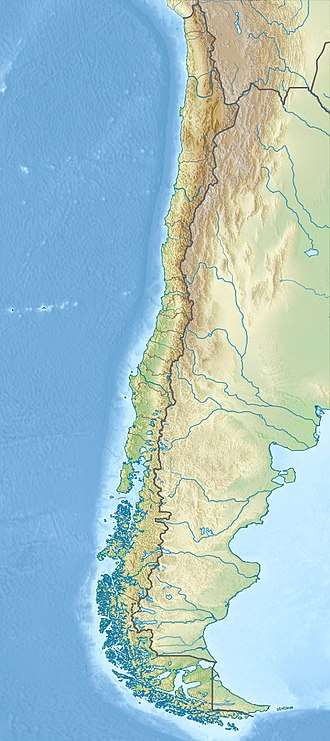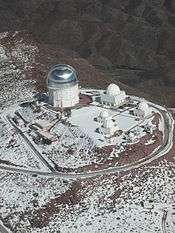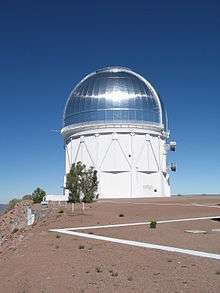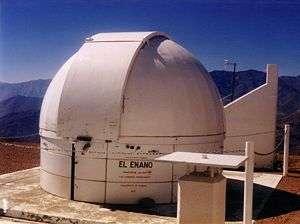Cerro Tololo Inter-American Observatory
The Cerro Tololo Inter-American Observatory (CTIO) is an astronomical observatory located on Cerro Tololo in the Coquimbo Region of northern Chile, with additional facilities located on Cerro Pachón about 10 kilometres (6.2 mi) to the southeast. It is within the Coquimbo Region and approximately 80 kilometres (50 mi) east of La Serena, where support facilities are located. The site was identified by a team of scientists from Chile and the United States in 1959, and it was selected in 1962.[1][2] Construction began in 1963 and regular astronomical observations commenced in 1965.[3] Construction of large buildings on Cerro Tololo ended with the completion of the Víctor Blanco Telescope in 1974, but smaller facilities have been built since then. Cerro Pachón is still under development, with two large telescopes inaugurated since 2000, and one in the early stages of construction.
 Cerro Tololo and the Blanco Telescope viewed from the summit access road | |||||||||||||||||||||||||||||
| Alternative names | CTIO | ||||||||||||||||||||||||||||
|---|---|---|---|---|---|---|---|---|---|---|---|---|---|---|---|---|---|---|---|---|---|---|---|---|---|---|---|---|---|
| Organization | National Optical Astronomy Observatory | ||||||||||||||||||||||||||||
| Observatory code | 807 | ||||||||||||||||||||||||||||
| Location | Coquimbo Region, Chile | ||||||||||||||||||||||||||||
| Coordinates | 30°10′11″S 70°48′23″W | ||||||||||||||||||||||||||||
| Altitude | 2,207 m (7,241 ft) | ||||||||||||||||||||||||||||
| Established | 1962 | ||||||||||||||||||||||||||||
| Website | www | ||||||||||||||||||||||||||||
| Telescopes | |||||||||||||||||||||||||||||
| |||||||||||||||||||||||||||||
 Location of Cerro Tololo Inter-American Observatory | |||||||||||||||||||||||||||||
The principal telescopes at CTIO are the 4 m Víctor M. Blanco Telescope, named after Puerto Rican astronomer Victor Manuel Blanco, and the 4.1 m Southern Astrophysical Research (SOAR) telescope, which is situated on Cerro Pachón.[4] Other telescopes on Cerro Tololo include the 1.5 m, 1.3 m, 1.0 m, and 0.9 m telescopes operated by the SMARTS consortium. CTIO also hosts other research projects, such as PROMPT, WHAM, and LCOGTN, providing a platform for access to the southern hemisphere for U.S. and worldwide scientific research.[5]
Organization
CTIO is one of two observatories managed by the National Optical Astronomy Observatory (NOAO), the other being Kitt Peak National Observatory (KPNO) near Tucson, Arizona. NOAO is operated by the Association of Universities for Research in Astronomy (AURA), which owns the property around the two peaks in Chile and at the headquarters in La Serena, Chile. AURA also operates the Space Telescope Science Institute and the Gemini Observatory. The 8.1 m (320 in) Gemini South Telescope located on Cerro Pachón is managed by AURA separately from CTIO for an international consortium.[6][7] The National Science Foundation (NSF) is the funding agency for NOAO.[4]
The Small and Medium Research Telescope System (SMARTS) is a consortium formed in 2001 after NOAO announced it would no longer support anything smaller than two meters at CTIO.[8] The member institutions of SMARTS now fund and manage observing time on four telescopes that fit that definition. Access has also been purchased by individual scientists.[9] SMARTS contracts with NOAO to maintain the telescopes it controls at CTIO, and NOAO retains the right to 25% of the observing time, and Chilean scientists retain 10%. SMARTS began managing telescopes in 2003.[8]
CTIOPI is the Cerro Tololo Interamerican Observatory Parallax Investigation. It began in 1999 and uses two telescopes at Cerro Tololo, the SMARTS 1.5 m reflector and the SMARTS 0.9 m reflector. The purpose of CTIOPI is to discover nearby red, white, and brown dwarfs that lurk unidentified in the solar neighborhood. The goal is to discover 300 new southern star systems within 25 parsecs by determining trigonometric parallaxes accurate to 3 milliarcseconds.
Telescopes
- The 4.0 m (158 in) Victor M. Blanco Telescope (Blanco 4m) was completed in 1974 and is very similar to the Nicholas U. Mayall Telescope which was completed at KPNO in 1973.[10] Testing of the telescope and instruments lasted until the beginning of 1976 when science operations began.[11] The Blanco 4m is the only telescope on Cerro Tololo managed directly by NOAO.[4]30°10′10.78″S 70°48′23.49″W
- The 4.1 m (161 in) Southern Astrophysical Research Telescope (SOAR) is an optical and near-infrared telescope located on Cerro Pachón. It was dedicated in 2004 and is managed by NOAO for an international consortium of which NOAO is a partner.[4][12]30°14′16.41″S 70°44′01.11″W
SMARTS Telescopes
- The 1.5 m (59 in) SMARTS Telescope is a Cassegrain reflector on an equatorial mount. Regular observations began in 1968.[13]30°10′09.42″S 70°48′24.44″W
- The 1.3 m (51 in) SMARTS Telescope is a Cassegrain reflector on an equatorial mount. It was built by M3 Engineering and Technology Corporation and used for the 2-micron All-Sky Survey (2MASS). It began operating in 1998 and was given to CTIO in 2001 after the survey was completed.[14]30°10′02.81″S 70°48′17.92″W
- The 1.0 m (39 in) SMARTS Yale Telescope is a closed-tube Cassegrain reflector built by Boller and Chivens. It was first installed in 1965 at the Bethany Observing Station of the Yale University Observatory.[15] It was moved to CTIO in 1974.[16] From 1998 to 2002, it was used by the Yale University-AURA-University of Lisbon-Ohio State University (YALO) consortium with a custom-built sensor. In 2004 it was integrated into SMARTS.[8]30°10′07.92″S 70°48′21.83″W
- The 0.9 m (35 in) SMARTS Telescope is a closed-tube Cassegrain reflector. It was installed at CTIO in 1966.[17]30°10′07.90″S 70°48′23.86″W
Tenant telescopes
- The 0.6 m (24 in) Southeastern Association for Research in Astronomy (SARA) South Telescope is a reflecting telescope built by Boller and Chivens. Installed in 1968 for the International Planetary Patrol Program, it was owned and operated by Lowell Observatory. At some point control shift to CTIO, which lasted until 1996, after which Lowell used the telescope intermittently.[18] It was refurbished by SARA and put back into use in 2010.[19] Observing time is shared between the members of the SARA consortium. 30°10′19.72″S 70°47′57.13″W
- The 0.61 m (24 in) Curtis-Schmidt Telescope is a Schmidt camera that was installed at CTIO in 1966.[3] It was previously located at the University of Michigan's Portage Lake Observatory. It is currently used for the Michigan Orbital DEbris Survey Telescope (MODEST) project, which is part of NASA's program to detect and catalog orbital debris.[20] Two-thirds of observing time was at the discretion of NOAO prior to 2001.[17] From 1989 to 1995 it was used in part by the Calán/Tololo Survey. 30°10′08.60″S 70°48′22.63″W
- The Wisconsin H-Alpha Mapper (WHAM) is a custom-built 0.6 m (24 in) telescope used to study the warm ionized medium. In 2009, it was moved to CTIO from KPNO, where it operated from 1996 to 2008.[21]30°10′05.92″S 70°48′12.85″W
- A 0.5 m (20 in) reflecting telescope built by Officina Stellare of Italy was installed in 2010 as part of the Chilean Automatic Supernova Search (CHASE).[22] The project is run by the Center for Excellence in Astrophysics and Associated Technologies (CATA) of the University of Chile Department of Astronomy. The telescope will also be part of Global Robotic-telescopes Intelligent Array (GLORIA).[23] It is located in the building that previously housed the Millimeter-wave Telescope. 30°10′06.97″S 70°48′21.65″W The existing dome was replaced by a new clamshell-style dome as part of the project. CHASE has used the PROMPT telescopes for 10% of the time since 2009.
- The Panchromatic Robotic Optical Monitoring and Polarimetry Telescopes (PROMPT) installation consists of five 0.4 m (16 in) Ritchey-Chrétien reflectors built by RC Optical Systems. Each telescope is fitted with a filter and camera designed to observe gamma ray bursts at different wavelengths. When not observing an event, the telescopes are used remotely by public school students in North Carolina. Construction of six fully automated domes started in 2004 and the telescopes began operating in 2006.[24] The status of a sixth telescope, originally planned to observe at near-infrared wavelengths, is unclear. The building for a seventh PROMPT telescope, a larger 0.8 m (31 in) unit, was completed in 2011.[25]30°10′03.52″S 70°48′18.91″W
- The Global Oscillations Network Group (GONG) deployed an observing station to study helioseismology in 1995.[26]30°10′03.92″S 70°48′19.84″W
- Eight 40 cm telescopes, each equipped with a CCD camera sensitive to red optical and near-infrared light used by the MEarth Project.[27]
Former telescopes
- The 1.2 m (47 in) Millimeter-wave Telescope is a Cassegrain reflector with a primary mirror made of machined aluminum, remachined in USA by Phelps-Dodge to a surface accuracy of lambda/400.[28] It was installed at CTIO in 1982, and an identical telescope is located at the Harvard-Smithsonian Center for Astrophysics. It was used for spectrometric mapping-surveys of the distribution of Carbon Monoxide at a rest-wavelength of 2.6 millimeters in molecular clouds in the third and fourth quadrants of the Milky Way, and in the Magellanic Clouds while at CTIO. In 2009 it was moved to the Chilean National Astronomical Observatory's campus on Cerro Calán near Santiago.[29]30°10′06.97″S 70°48′21.65″W
- A 0.41 m (16 in) telescope was transported to the summit on mules in 1961 to perform site testing.[2] It was later installed in a dome at CTIO in 1965.[3] Its dome was used by the Millimeter-wave Telescope beginning in 1982.30°10′06.97″S 70°48′21.65″W
- A second 0.41 m (16 in) telescope was installed in 1965.[3] It was removed at some point and the building was used for UCAC.30°10′06.95″S 70°48′22.82″W
- A 0.2 m (7.9 in) astrograph was used by the USNO CCD Astrograph Catalog (UCAC) project from 1998 to 2001. It was located in one of the 16-inch telescope domes. After surveying the southern sky it was moved to United States Naval Observatory Flagstaff Station to complete its mission.[30]30°10′06.95″S 70°48′22.82″W
- The Southern H-Alpha Sky Survey Atlas (SHASSA) operated at CTIO from 1997 to 2006 in its own small dome, which was dubbed El Enano ('the Dwarf') by the local staff.[31][32] It was removed at the end of the project and donated to a school in La Serena.[33]
Future telescopes
- Las Cumbres Observatory Global Telescope Network is building three 1.0 m (39 in) telescopes at Cerro Tololo. Construction of the domes began in 2010 and was completed in 2011.[34][35] The telescopes will be made available for scientific and educational use, and a set of smaller telescopes is planned.30°10′02.58″S 70°48′17.24″W
- The Vera C. Rubin Observatory (LSST) is a 8.4 m (330 in) reflecting telescope under construction on Cerro Pachón. Construction began in 2011 and first light is expected in late 2015.[36] It will be used for an astronomical survey similar to the 2MASS survey performed at CTIO. As with Gemini, the LSST will be managed separately from CTIO.30°14′40.68″S 70°44′57.90″W. A smaller 1.4-meter support telescope for LSST will be built on an adjacent peak.30°14′41.27″S 70°44′51.80″W
- A 1.6-meter telescope supporting the Korean Microlensing Telescope Network (KMTNet), led by the Korea Astronomy and Space Science Institute (KASI), is currently under construction on Cerro Tololo.[37]30°10′01.84″S 70°48′14.39″W
- A 0.82-meter telescope called "T80-South" supporting the Southern Massive Astrophysical Panchromatic Survey (S-MAPS) project is scheduled to be built on Cerro Tololo.30°10′04.31″S 70°48′20.48″W The S-MAPS project is also proposing to build a larger 2.55-meter telescope on Cerro Pachon.[38]
Discoveries
| Asteroids discovered: 5 | |
|---|---|
| (87269) 2000 OO67 | July 29, 2000 |
| (87555) 2000 QB243 | August 25, 2000 |
| 88611 Teharonhiawako | August 20, 2001 |
| (134210) 2005 PQ21 | August 9, 2005 |
| (139775) 2001 QG298 | August 19, 2001 |
| Supernovas discovered: 1 | |
|---|---|
| December 7, 2013 | |
On the morning of Saturday, December 7, 2013, Luis González, a research assistant at the University of Chile, discovered what would later be confirmed as a supernova by José Maza, an astronomer at University of Chile and a researcher for CATA (Centro de Astrofísica y Tecnologías Afines or “Centre for Astrophysics and Related Technologies”). The supernova is the first discovery to be made by the CATA 500, a robotic telescope designed and operated by a Chilean team located in Santiago, approximately 500 kilometres to the south.[39] It is part of the GLORIA project, which provides open access to astronomers from around the world to a network of remotely operated robotic telescopes.[40] The new supernova lies in the galaxy ESO 365-G16, located 370 million light years from Earth, and has a mass eight times that of our Sun.[41]
Gomez's Hamburger, believed to be a young star surrounded by a protoplanetary disk, was discovered in 1985 on sky photographs obtained by Arturo Gomez, support technical staff at the Observatory.[42]
Gallery
| Wikimedia Commons has media related to CTIO. |
 General view of CTIO grounds
General view of CTIO grounds Aerial view looking south
Aerial view looking south- Aerial view looking east
 Victor M. Blanco Telescope
Victor M. Blanco Telescope Swarthmore H-alpha survey telescope
Swarthmore H-alpha survey telescope Telescopes and other facilities on the summit of Cerro Tololo
Telescopes and other facilities on the summit of Cerro Tololo
See also
- List of astronomical observatories
- Llano de Chajnantor Observatory
- Paranal Observatory
- La Silla Observatory
- MCELS (Magellanic Cloud Emission-line Survey)
- Very Large Telescope
- European Extremely Large Telescope
- Tololo-1247-232 - One of only two known Lyman continuum photons emitters.
- MEarth Project
References
- Moreno, H. (1990). "Chilean Astronomers and the Birth of Cerro Tololo". Revista Mexicana de Astronomía y Astrofísica. 21: 683. Bibcode:1990RMxAA..21..683M.
- "CTIO History | CTIO". Cerro Tololo Inter-American Observatory. Retrieved 2012-02-01.
- "OBSERVATORY REPORT: Kitt Peak-Cerro Tololo Inter-American". Astronomical Journal. 71: 229. 1966. Bibcode:1966AJ.....71..229.. doi:10.1086/109912.
- "About CTIO | CTIO". Cerro Tololo Inter-American Observatory. Archived from the original on 2012-04-18. Retrieved 2012-02-01.
- "Programs & Related Items | CTIO". Cerro Tololo Inter-American Observatory. Retrieved 2012-02-01.
- "Media Invited to Gemini South Dedication January 18, 2002, La Serena and Cerro Pachón, Chile". Gemini Observatory. Retrieved 2012-02-01.
- "About The Gemini Observatory". Gemini Observatory. Retrieved 2012-02-01.
- "SMARTS History | CTIO". Cerro Tololo Inter-American Observatory. Retrieved 2012-02-01.
- "Joining SMARTS | CTIO". Cerro Tololo Inter-American Observatory. Archived from the original on 2012-04-29. Retrieved 2012-02-01.
- Goldberg, L. (1976). "Kitt Peak National Observatory, Tucson, Arizona; Cerro Tololo Inter-American Observatory, La Serena, Chile. Observatory reports". Bulletin of the Astronomical Society. 8: 129. Bibcode:1976BAAS....8..129G.
- Goldberg, L.; Blanco, V. (1978). "Kitt Peak National Observatory, Tucson, Arizona; Cerro Tololo Inter-American Observatory, La Serena, Chile. Reports". Bulletin of the Astronomical Society. 10: 152. Bibcode:1978BAAS...10..152G.
- "SOAR Status — Southern Astrophysics Research Telescope". SOAR. Archived from the original on 2012-04-14. Retrieved 2012-02-01.
- Mayall, N. U. (1969). "Kitt Peak National Observatory, Tucson, Arizona and Cerro Tololo Inter-American Observatory, La Serena, Chile. Report 1968-1969". Bulletin of the Astronomical Society. 1: 298. Bibcode:1969BAAS....1..298M.
- "2MASS - Telescopes". The University of Massachusetts Amherst Astronomy Department. Archived from the original on 2011-03-10. Retrieved 2012-02-01.
- "The Yale-CTIO Collaboration: Past and Future". National Optical Astronomy Observatory. 1 December 1997. Retrieved 2012-02-03.
- Lippincott, S. L.; Heintz, W. D. (1975). "Sproul Observatory, Swarthmore College, Swarthmore, Pennsylvania. Observatory report". Bulletin of the Astronomical Society. 7: 106. Bibcode:1975BAAS....7..106L.
- Mayall, N. U. (1968). "Facilities for Visitors at Kitt Peak National Observatory and Cerro Tololo Inter-American Observatory". Zeitschrift für Astrophysik. 68: 222. Bibcode:1968ZA.....68..222M.
- "Lowell 0.6-m Telescope to be Mothballed". National Optical Astronomy Observatory. 1 March 1996. Retrieved 2012-02-03.
- "A Brief History of SARA". Southeastern Association for Research in Astronomy. Archived from the original on 2013-09-20. Retrieved 2012-02-01.
- "Michigan Astronomy | Observatories: Curtis-Schmidt Telescope". University of Michigan Department of Astronomy. Archived from the original on 2012-01-21. Retrieved 2012-02-01.
- "WHAM Description". University of Wisconsin Department of Astronomy. Retrieved 2012-02-01.
- Hamuy, Mario (2011-05-27). "CHASE: Chilean Automatic Supernova Search" (PDF). Retrieved 2012-02-06.
- "Chile forma parte del recién creado "facebook" astronómico mundial su nombre es GLORIA". 2011-11-05. Retrieved 2012-02-06.
- "PROMPT Announcement". University of North Carolina at Chapel Hill Department of Physics and Astronomy. Retrieved 2012-02-01.
- "SKYNET News Archives". University of North Carolina at Chapel Hill Department of Physics and Astronomy. Retrieved 2012-02-03.
- "NSO/GONG: Site - Cerro Tololo". National Solar Observatory. Retrieved 2012-01-15.
- https://www.cfa.harvard.edu/MEarth/Telescopes.html
- "The 1.2 m Telescopes". Harvard-Smithsonian Center for Astrophyics Millimeter-wave Group. Retrieved 2012-02-01.
- "Millimeter-wave Laboratory". Universidad de Chile Department of Astronomy. Retrieved 2012-02-01.
- Zacharias, M. I.; Zacharias, N. (2003). "The U. S. Naval Observatory CCD Astrograph Catalog project". Astronomy in Latin America: 109. Bibcode:2003ala..conf..109Z.
- Gaustad, John E.; McCullough, Peter R.; Rosing, Wayne; Van Buren, Dave (2001). "A Robotic Wide‐Angle Hα Survey of the Southern Sky". Publications of the Astronomical Society of the Pacific. 113 (789): 1326. arXiv:astro-ph/0108518. Bibcode:2001PASP..113.1326G. doi:10.1086/323969.
- "New White Dwarf Appears on Cerro Tololo". National Optical Astronomy Observatory. 1 March 1997. Retrieved 2012-02-03.
- Ochoa, Hugo; Norman, Dara (1 September 2006). "The Dwarf Moves to a New Home" (PDF). National Optical Astronomy Observatory. Retrieved 2012-02-03.
- "Cerro Tololo". Las Cumbres Observatory Global Telescope Network. Retrieved 2012-02-01.
- "Update at Chile Site". Las Cumbres Observatory Global Telescope Network. Archived from the original on 2013-02-21. Retrieved 2012-02-03.
- "LSST Timeline | LSST". LSST Corporation. Archived from the original on 2012-01-31. Retrieved 2012-02-01.
- Kim, Seung-Lee; et al. (15 September 2011), "Wide-field telescope design for the KMTNet project", Techniques and Instrumentation for Detection of Exoplanets V. SPIE Conference Proceedings, 8151: 81511B
- "S-MAPS Sites and Telescopes". Archived from the original on 31 December 2012. Retrieved 15 October 2012.
- Dramatic supernova find by Chilean team thisischile.cl, January 07, 2014, retrieved January 10, 2014
- GLORIA project - about gloria-project-eu, retrieved January 12, 2014.
- Telescopio chileno capta su primera supernova {es} latercera.cl, Cristina Espinoza C., December 19, 2013, retrieved January 10, 2014.
- "Gomez's Hamburger".
External links
| Wikimedia Commons has media related to CTIO. |